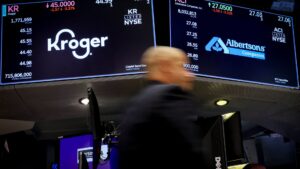Kroger and Albertsons Merger: A Corporate Breakup Unfolds
In a dramatic turn of events, Albertsons has officially called off its proposed $25 billion merger with rival Kroger, escalating tensions into a legal showdown. This decision comes just a day after a judicial ruling blocked the anticipated corporate alliance. The implications for investors and consumers alike are significant, as the struggle between these two retail giants evolves.
The Litigation Landscape
Albertsons has taken a strong stance in its lawsuit against Kroger, contending that the supermarket chain violated their merger agreement by failing to divest necessary assets to secure antitrust approval. According to Albertsons, Kroger not only ignored feedback from regulators but also rejected potential buyers for the divestitures, thus jeopardizing the merger that was meant to strengthen their competitive position against retail titans like Walmart, Amazon, and Costco.
Albertsons’ General Counsel, Tom Moriarty, articulated the sentiment that Kroger’s "self-serving conduct" has adversely affected shareholders, employees, and consumers. He expressed disappointment over the lost opportunity to harness the purported benefits the merger could have provided.
Kroger’s Counterarguments
In defense, Kroger has dismissed Albertsons’ claims as "baseless and without merit," arguing that the suit is merely an effort to distract from their own contractual breaches. The retailer asserts that the litigation reflects Albertsons’ attempt to secure a share of the merger’s break fee, which Kroger insists is unwarranted.
The Merger’s Anticipated Impact
Initially announced two years ago, the merger was meant to combine approximately 40 supermarket chains, including Kroger’s Fred Meyer and Albertsons’ Safeway. The rationale behind the merger was clear: to create a formidable force in the grocery sector capable of competing with larger players in an increasingly competitive landscape.
The deal promised enhancements in scale, operational efficiencies, and the potential for increased investment in customer experiences. However, even as the legal battle commences, the question remains—what does this mean for consumers?
What Lies Ahead for Investors and Consumers
As the lawsuit unfolds, both companies face uncertainty. Albertsons is pursuing a $600 million termination fee, coupled with claims for further financial relief for the investments made during the long-winded merger discussions. Conversely, Kroger is steadfast in its position, hinting that they will robustly defend against these allegations in court.
For investors, understanding the ramifications of this legal battle is crucial. These events may affect stock performance, as market trends can be swayed by stories of corporate stability—or instability. Early indications show slight increases in stock prices, with Albertsons and Kroger shares rising about 0.5% and 1%, respectively. However, the ongoing legal drama could lead to volatility.
Final Thoughts
The saga between Kroger and Albertsons serves as a reminder of the complexities involved in corporate mergers and acquisitions, especially in regulated sectors. This situation extends beyond mere numbers; it has real implications for jobs, consumer choices, and market competition.
At Extreme Investor Network, we pride ourselves on delving deeper into these corporate narratives to uncover what they mean for your investment strategy. Stay tuned with us as we continue to monitor this evolving situation and provide insights that can help you navigate the often turbulent waters of the business world. Sign up for our newsletter and gain access to expert analysis that sets you one step ahead of the curve.

